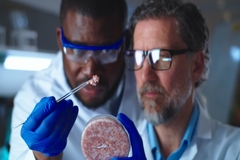Study examines scalable tissue biofabrication via perfusable hollow fibers for cultured meat
New research has developed a platform with the potential to revolutionize cultured meat production and the biofabrication of large-scale engineered tissues, opening transformative opportunities in cellular agriculture.
The paper addresses the whole-cut challenge in the cultivated meat space by using a Hollow Fiber Bioreactor (HFB). This mimics a circulatory system to deliver nutrients and oxygen across thick tissue constructs. So far, headway has been made in developing cultivated meat with a mince-like appearance while creating whole cuts of meat has proved more difficult.
It is considered a unique system because of the cell alignment and muscle cell differentiation, showing potential for fibrous aligned products generated by the cells themselves.
Overcoming roadblocks
The concept of using HFBs for producing large-scale engineered tissues, such as cultured meat, has been around for some time, say the researchers, but current systems are limited to producing sparse clumps of cell spheroids rather than functional tissues with consistent morphology on a centimeter scale.
They say that a significant challenge lies in the random distribution of hollow fibers, which prevents uniform nutrient delivery and compromises tissue quality.
The researchers introduced a bioreactor with a scalable array of closely arranged hollow fibers featuring microscale distribution uniformity, and successfully demonstrated the production of centimeter-scale tissue with minimal necrosis.
This shows the potential of this platform for large-scale tissue manufacturing.
The study — Scalable tissue biofabrication via perfusable hollow fiber arrays for cultured meat applications — was published in Trends in Biotechnology recently.
Boost for cultivated meat
Cultivated meat is a burgeoning industry offering a promising alternative to conventional meat because it offers the potential to reduce environmental impacts such as greenhouse gas emissions, land and water use as well as eliminate the need for animal slaughter, and improve food safety by avoiding the use of antibiotics and reducing the risk of zoonotic diseases.
“We developed a novel HFB using high-precision stereolithography to achieve the long-term perfusion of scalable artificial tissue. Our experiments confirmed that the applied pressures within the hollow fibers increased not only the confluency, but also promoted the differentiation activity of cells. In addition, the improvement of the spatial distribution of the hollow fibers benefited the morphological consistency in the resulting tissue,” says the paper.
However, it also flags that in order to advance this approach, the development of parallel fiber arraying methods is crucial for the efficient large-scale manufacturing of the HFBs.
“With continued development, this platform has the potential to revolutionize cultured meat production and the biofabrication of large-scale engineered tissues, opening transformative opportunities in cellular agriculture, regenerative medicine, and beyond.”
Reaction to the study
A range of experts have responded to the study with enthusiasm, noting that the innovative research helps address the whole-cut challenge.
Professor Derek Stewart, director of the Advanced Plant Growth Centre and co-director of the National Alternative Protein Innovation Centre, the James Hutton Institute, says, “This is an exciting advance in the alternative protein sector and specifically culture meat, and addresses many of the challenges that were seen as stumbling blocks such as aligned cell growth to deliver the meat texture sensory experience as well as the fundamental issues of getting nutrients and oxygen to the growing solid meat tissue.”
“The use of hollow fiber supports (in essence scaffolds) and the advances herein will open up many areas of allied research (and undoubtedly investment) with scaleup options now seemingly achievable with the progression from this paper in terms of better sensors, robotics and ultimately AI for control.”
Dr Rodrigo Amaro-Ledesma, director of the Bezos Centre for Sustainable Protein, Imperial College London, says that one of the key goals for cultivated meat is replicating the texture and structure of whole-cut products, such as chicken breast or steak.
“Muscle tissue needs oxygen and nutrients delivered deep into the structure to remain viable. As a result, most cultivated meat companies have initially focused on producing unstructured or ‘mince-style’ products, which are more feasible to produce at scale with current technologies.”
“It’s a meaningful technical achievement that they have produced a cultivated chicken meat several centimeters thick. If you combine that with the research we’re conducting at the Bezos Centre for Sustainable Protein — fine-tuning flavor profiles and exploring alternative, cost-effective raw materials — we’re comfortably on track toward an exciting and appealing new range of products.”










